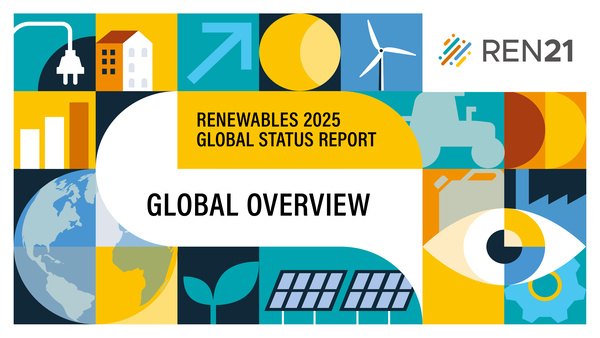Renewables 2025 Global Status Report: Global Overview
In 2024, global renewable energy growth was primarily driven by the power sector, where capacity expanded by 741 gigawatts (GW), the largest annual increase ever recorded. Solar photovoltaics (PV) led...

Abstract
In 2024, global renewable energy growth was primarily driven by the power sector, where capacity expanded by 741 gigawatts (GW), the largest annual increase ever recorded. Solar photovoltaics (PV) led this growth, supported by rapidly falling costs, large-scale deployments and mature supply chains; however, growth in wind energy installations slowed. Deployment of battery storage hit record levels, driven by falling prices and growing recognition of storage as critical for grid reliability. Despite this momentum, renewable energy growth could not keep pace with rising global electricity demand. Growth in electricity demand was driven by higher temperatures, industrial expansion and rapid electrification in emerging markets. Data centres consumed large amounts of electricity as use of artificial intelligence (AI) technologies continued to grow. Renewables were deployed to meet some of this demand, and fossil fuels filled the gap. Global energy-related carbon dioxide (CO2) emissions increased 0.8% compared to 2023. The year 2024 was the hottest on record, and for the first time the global average temperature exceeded 1.5 degrees Celsius (°C) above pre-industrial levels over a full calendar year. Climate impacts intensified worldwide: Los Angeles (United States) faced severe wildfires, Valencia (Spain) experienced extreme flooding, droughts hit Latin America, and flash floods inundated the Caribbean. These events disrupted communities, economies, and energy systems, with vulnerable regions suffering the most. This series of disasters again emphasises that the climate emergency is not a future threat it is already disrupting lives and livelihoods across the planet. Energy security remained in the spotlight in 2024, as geopolitical tensions, trade disruptions and rising economic nationalism influenced national energy strategies. Countries sought to secure supply, reduce external dependencies and control prices. While some countries accelerated their investments in renewables and energy storage to reduce risk and increase resilience, fossil fuel investments also grew, often driven by industrial lobbying and short-term security concerns. As these developments underscore, the energy transition is shaped not only by technical and economic factors, but also by political and governance choices, domestic pressures and competing visions of national interest. Renewable energy is no longer just a climate solution; it is essential infrastructure. In a world of intersecting crises, renewables support sustainable economic development, public health and energy security.
Publication Details
Authors: REN21
Venue: REN21 Year: 2025 Institution: REN21
Links and Resources
Keywords
featured